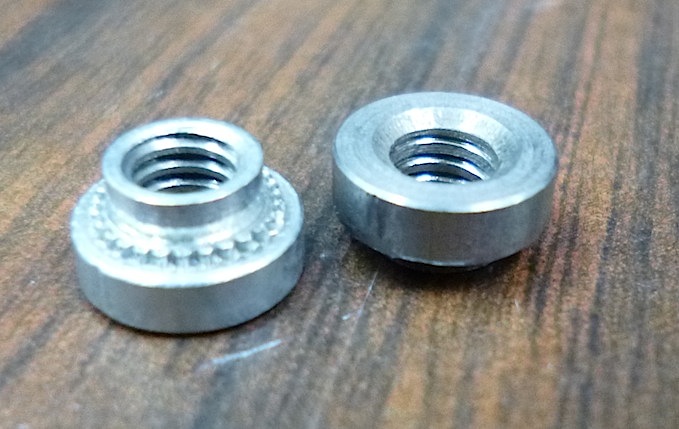Swage Nut on:
[Wikipedia]
[Google]
[Amazon]
 A swage nut or self-clinching nut is a type of
A swage nut or self-clinching nut is a type of
nut
Nut often refers to:
* Nut (fruit), fruit composed of a hard shell and a seed, or a collective noun for dry and edible fruits or seeds
* Nut (hardware), fastener used with a bolt
Nut or Nuts may also refer to:
Arts, entertainment, and media Co ...
or threaded insert
A threaded insert, also known as a threaded bushing, is a fastener element that is inserted into an object to add a threaded hole. They may be used to repair a stripped threaded hole, provide a durable threaded hole in a soft material, place a thr ...
that is used on sheet metal
Sheet metal is metal formed into thin, flat pieces, usually by an industrial process. Sheet metal is one of the fundamental forms used in metalworking, and it can be cut and bent into a variety of shapes.
Thicknesses can vary significantly; ex ...
.
It permanently anchors itself to the sheet metal by swaging
Swaging () is a forging process in which the dimensions of an item are altered using dies into which the item is forced. Swaging is usually a cold working process, but also may be hot worked.
The term swage may apply to the process (verb) o ...
the surrounding material. Generally, the swage nut is made of a hard metal such as stainless steel
Stainless steel is an alloy of iron that is resistant to rusting and corrosion. It contains at least 11% chromium and may contain elements such as carbon, other nonmetals and metals to obtain other desired properties. Stainless steel's corros ...
, which is inserted into a pre-drilled hole in a softer ductile
Ductility is a mechanical property commonly described as a material's amenability to drawing (e.g. into wire). In materials science, ductility is defined by the degree to which a material can sustain plastic deformation under tensile stres ...
material such as aluminum
Aluminium (aluminum in American and Canadian English) is a chemical element with the symbol Al and atomic number 13. Aluminium has a density lower than those of other common metals, at approximately one third that of steel. It has ...
. The inserted shank has three diameters: a main shaft which fits the hole closely, a thin smaller-diameter undercut
Undercut may refer to:
* Price slashing, a pricing technique designed to eliminate competition
*Undercut procedure, a procedure for fair allocation of indivisible objects.
* Undercut (boxing), a type of boxing punch
* ''Undercut'' (film), a stunt ...
, and a larger-diameter serrated
Serration is a saw-like appearance or a row of sharp or tooth-like projections. A serrated cutting edge has many small points of contact with the material being cut. By having less contact area than a smooth blade or other edge, the applied p ...
clinching ring. Forcing the clinching ring into softer material, with an arbor press
An arbor press is a small hand-operated press. It is typically used to perform smaller jobs, such as staking, riveting, installing, configuring and removing bearings and other press fit work. Punches, inserters, or other tools/dies may be add ...
or by tightening a screw through the hole, causes it to plastically deform (swage
Swaging () is a forging process in which the dimensions of an item are altered using dies into which the item is forced. Swaging is usually a cold working process, but also may be hot worked.
The term swage may apply to the process (verb) or ...
) into the annular
Annulus (or anulus) or annular indicates a ring- or donut-shaped area or structure. It may refer to:
Human anatomy
* '' Anulus fibrosus disci intervertebralis'', spinal structure
* Annulus of Zinn, a.k.a. annular tendon or ''anulus tendineus co ...
recess in the shank. This locks the nut into the hole. The knurling
Knurling is a manufacturing process, typically conducted on a lathe, whereby a pattern of straight, angled or crossed lines is rolled into the material.
Etymology
The terms ''knurl'' and ''knurled'' are from an earlier ''knur'' ‘knot in woo ...
on the clinching ring is not necessary for this step, but prevents the nut from rotating after installation.
This is a popular method for adding strong, load-bearing threads to a relatively thin piece of soft sheet metal.
Self-clinching nuts are described in National Aerospace Standard NASM45938 which supersedes military specification MIL-N-45938
History
Albert Spokes filed for a U.S. patent on the swage nut in early 1958. The swage nut is descended from an older idea, the clinch nut. Clinch nuts incorporate a tubular shaft that fits through the part to be attached and is clinched or riveted in place from the opposite side.See also
*Rivet nut
A rivet nut, also known as a blind rivet nut, or rivnut, is a one-piece internally threaded and counterbored tubular rivet that can be anchored entirely from one side. It is a kind of threaded insert. There are two types: one is designed to for ...
* Friction drilling
Friction drilling is a method of making holes in metal in which the material is pushed out of the way with the aid of heat from friction. The process is also called thermal drilling, flow drilling, form drilling, or friction stir drilling.
Fricti ...
References
{{Nuts (hardware) Nuts (hardware) Fasteners